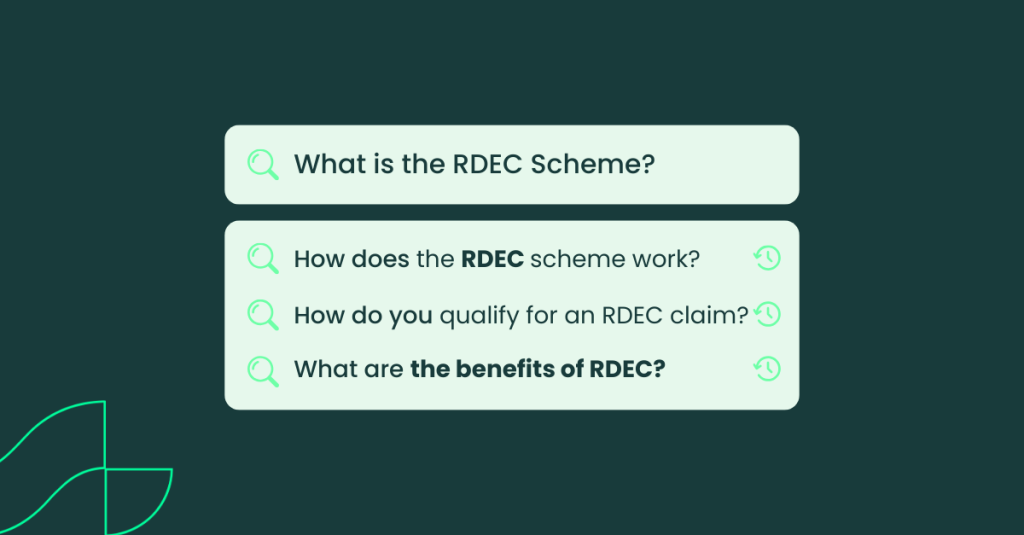Understanding the RDEC tax credit for large companies
1 September 2023

The RDEC scheme, also known as the Research and Development Expenditure Credit, actively supports innovations and technological advancements. Your ideas have the potential to create positive change for the planet, the economy, and for people. Failure and loss often come with research and development, which is why you can benefit from the RDEC scheme even if you’ve made a loss.
What is the Meaning of RDEC?
The Research and Development Expenditure Credit (RDEC) is a UK government incentive that offers a taxable credit on the qualifying R&D expenditures of large companies. This credit can be claimed as a cash payment or used to offset Corporation Tax liabilities, even if the company is making a loss. Introduced in 2002, RDEC helps drive innovation in industries like science, technology, and engineering by allowing companies to reclaim a portion of their R&D costs.
Book a quick call back
What is the RDEC tax credit?
The Research and Development Expenditure Credit (RDEC) is a government scheme that was introduced in 2002. The RDEC scheme offers larger companies the opportunity to reclaim their qualifying expenditures incurred as a result of R&D activities. The outcome of a successful claim can result in either a cash payment or the offsetting of a portion of their corporation tax.
Who qualifies for the RDEC scheme?
The RDEC Scheme is formulated for larger companies that exhibit the following characteristics:
- A headcount of more than 500 staff
- A turnover of over €100 million
- Or a balance sheet total of/or above €86 million
💡 These companies need to be involved in R&D activities, incurring expenses related to these activities within the UK, and also paying corporation tax in the UK.
What is the RDEC tax credit rate?
There have been recent changes to the RDEC rate, in favour of supporting larger companies. The calculation of the expenditure credit is determined based on a proportion of your eligible R&D expenses, with specific rates as follows:
Before April 2023
The RDEC rate was 13% on expenditure incurred from 1st April 2020 up to and including 31 March 2023.
To illustrate, if you spent £500,000 worth of qualifying costs, you’ll receive 13% credit, which makes £65,000. This credit will be taxed at the 19% corporation tax rate meaning you receive a total of £52,650.
After April 2023
The RDEC rate is now 20% on expenditure incurred from 1 April 2023. For example, if you spent £500,000 worth of qualifying costs, you’ll receive 20% credit, which makes £100,000. Once taxed at the corporation tax rate of 19%, your net gain would be £81,000. This money makes a huge difference and shows how incredible the RDEC scheme is.
Curious about how much you can claim? Our free R&D tax credit calculator will give you an estimation in just a few clicks.
What are the qualifying costs for the RDEC tax credit?
These costs are associated with the expenditures incurred carrying out the qualifying R&D activities and are eligible for reimbursement as part of the R&D tax relief. Here is the breakdown of qualifying costs under the RDEC Scheme:
Staff PAYE costs/ pension contributions
You are eligible to request reimbursement for various expenses associated with staff members who are directly engaged in the R&D project and if these expenses are related to the R&D efforts. This includes items like bonuses, salaries, wages, pension fund contributions, and certain National Insurance contributions paid by the company. In specific situations, there is also the potential to claim for certain administrative or support staff expenses that are directly linked to a project, such as human resources expenses for recruiting a specific individual for the project or specialised cleaning staff. These are categorised as qualifying indirect activities.
Consumables & utilities
You have the option to request reimbursement for the appropriate portion of consumable items that were expended during the R&D process. This encompasses items like fuel, materials, power, and water. However, it’s important to note that you are ineligible to claim these expenses if you sell or transfer ownership of the consumable items that were utilised in the R&D activities.
Software purchases
Starting from accounting periods commencing on or after 1 April 2023, eligible expenditure has been expanded to encompass the pertinent components of data license expenses and expenses related to cloud computing.
A data license pertains to a license that permits the access and utilisation of a compilation of digital data.
Cloud computing encompasses various elements, including:
- Data storage
- Hardware facilities
- Operating systems
- Software platforms
You are entitled to claim most of the costs associated with data and cloud computing that have been utilised for research and development (R&D) purposes.
Clinical trial volunteers
In the field of pharmaceutical R&D projects, you have the opportunity to request reimbursement for payments provided to participants involved in clinical trials.
Travel costs
The travel costs incurred for the purpose of your research and development projects may also be eligible in your claim.
What are the costs that don’t qualify for the RDEC scheme?
R&D tax credits are specifically intended to assist companies engaged in trial and error for innovations and advancements. This implies that expenses related to the following are not eligible for the RDEC scheme:
- Capital expenditure, such as the purchase of land
- Expenses related to patents and trademarks
- Rent or rates
- Costs associated with the production and distribution of goods and services
- Redundancy payments
- Staff costs related to clerical or maintenance work that would have been performed regardless, such as payroll management.
What are the qualifying activities for the RDEC tax credit?
There is a broad spectrum of qualifying R&D activities across all industries. To gauge whether or not you’ve got an RDEC claim on your hands, we recommend you evaluate yourself based on the four-part test for RDEC.
The 4-part test: Qualifying for RDEC scheme at a glance
- Permitted purpose – Do you conduct any R&D activities that are centred around the aim of enhancing the performance, reliability, quality and functionality of a product or software?
- Technological uncertainty – At any point in your project, was there uncertainty regarding end results? Was there the possibility of potential unpredictable results that may arise during the development of a product or software, including the associated processes?
- The process of experimentation – Was there a need for a trial-and-error phase with the intention of overcoming technological uncertainties?
- Technological in nature – Looking at your R&D activities, did they fall within the domains of engineering, physical sciences, biological sciences, or computer science?
RDEC is all about the development of new or improved processes, products, and solutions, by overcoming technical challenges with explorative investigation through science and technology. If the answers are yes to these questions, then you are in a better position to start your RDEC claim!
What are the 7 steps to make an RDEC Claim?
To receive your RDEC payment, there are 7 key steps of an RDEC claim from start to finish that need to be completed. These steps will determine how you receive your benefit from R&D, whether that’s your credit being carried forward or a cash payment paid directly to you.
1. Settle your corporation tax liability
During this step, you will have to deduct any existing corporation tax obligations from the initial RDEC credit rate. If a credit surplus remains, it proceeds to the second step.
2. Calculating the net after-tax
To ensure you receive your RDEC benefit in cash, you need to check if the balance after step 1 exceeds the net credit value. By net credit value, it means the gross credit minus Corporation Tax. If it is the case that the balance is more than the net value of the credit, then this balance should be retained so it can be used in future tax periods.
3. Implement the NIC/PAYE cap
The R&D tax credits incentive is subject to a cap, known as the NIC/PAYE cap. The purpose of this cap is to prevent misuse of R&D tax relief, particularly considering that employee expenses commonly form a huge portion of a claim’s expenditure. It ensures you’re only benefiting the staff members and EPWs who were directly involved in the R&D. This limit is determined by the PAYE and NIC submitted to HMRC for the employees covered by your RDEC application.
4. Consider tax from other accounting periods
Before finalising the cash payment of the credit, HMRC might consider using it to offset any unpaid Corporation Tax from previous accounting periods rather than sending you a direct payment.
5. Choose surrendering for group relief
This is the time to choose whether to transfer the entire available credit amount to a group company, reducing their tax obligation for them. If you choose not to do this, you can still receive a cash payment if desired, regardless of the tax responsibilities of other group companies.
6. Settle additional obligations with HMRC
Upon reaching this point, any remaining sums will be collected by HMRC to cover outstanding taxes if there are any. These might encompass obligations such as VAT liabilities or overdue PAYE.
7. Receive your entitlement
Upon successful approval of your RDEC claim, you will receive the benefits in various forms, including corporation tax reduction, a cash refund, or a combination of both. This financial boost will help you reinvest in your business endeavours, including advancing more R&D projects.
What is the accounting treatment for the RDEC Tax Credit?
You have the opportunity to secure credit by inputting your expenses in the comprehensive Company Tax Return form (CT600). Nevertheless, since this claim falls into a special category, the credit will be recorded as additional income within your financial records. This advantageous arrangement can enhance the overall profitability of your enterprise or specific business division that is making the claim.
Based on whether your company is generating profits or experiencing losses, this credit can either offset liabilities or lead to a cash disbursement. However, the RDEC scheme benefit does not factor into the calculations for businesses that make quarterly payments.
💡 Navigating the accounting and taxation aspects of an RDEC claim can be tangled, and this underscores the significance of engaging R&D tax specialists who possess expertise in addressing both the tax and accounting policy ramifications. Speak to us!
Claiming for RDEC as an SME
There are certain circumstances where a small to medium-sized enterprise (SME) is eligible to claim for RDEC. These circumstances are:
- Using grants – If a small to medium-sized enterprise (SME) has conducted an R&D initiative financed by a grant or subsidy, the SME Scheme prohibits submitting a claim for the project covered by the grant. Conversely, under the RDEC Scheme, a claim is permissible for such a project.
- Subcontracting – If an SME is contracted by a larger company client, the SME can solely utilise the RDEC Scheme for their qualifying expenses. In this scenario, the SME subcontractor has been remunerated for conducting R&D, and might have gained a profit, yet can still make a claim under the RDEC relief scheme.
- If your company is owned by a larger company – If you’re involved in a partner enterprise or linked enterprise, you may be eligible for RDEC as opposed to the SME R&D tax credits. A partner enterprise is when a larger company has 25%-50% ownership over your SME. A linked enterprise is defined when your SME is majority-owned by a larger company.
What are the benefits of claiming RDEC tax credit?
The RDEC tax credit is an unmissable opportunity for large companies to receive the reward they are entitled to, particularly as the government has increased the RDEC rate. RDEC unlocks several benefits, including financial fuel for your business, improving your financial position, increasing competitiveness, and securing collaboration and partnerships.
The RDEC scheme is an unmissable opportunity for large companies to receive the reward they are entitled to, particularly as the government have increased the RDEC rate. RDEC unlocks the following benefits:
Receive financial fuel for your business
RDEC provides a tax credit that helps offset the costs associated with research and development (R&D) activities. This helps you to invest more into your project, supercharging your progress, without being held back by costs.
Financial position of a company
Unlike some other incentives, RDEC can be claimed regardless of whether the company is making a profit or operating at a loss. This allows companies to receive a tax credit even if they are not currently generating taxable profits.
Increase your competitiveness
By promoting R&D activities and getting a financial boost to reinvest more, the RDEC scheme helps companies remain competitive in their industries. It allows them to stay at the forefront of technological advancements and maintain their market positions.
Secure collaboration and partnerships
RDEC scheme encourages collaboration between companies, research institutions, and universities, fostering knowledge sharing and cross-industry partnerships to stimulate growth as a whole.
How can we help maximise your RDEC tax credit claim?
The specialist team at Alexander Clifford are deeply passionate about the transformations taking place that have been created by research and development. Our streamlined RDEC claim process has resulted in good news for hundreds of businesses that have embarked on tackling industry challenges with technological advancement. Our specialism in R&D helps us to reclaim every eligible penny for you.
What sets us apart?
- A high success rate with HMRC’s R&D office
- £83m+ Retrieved for our clients so far
- 5* Reviews from our happy clients
- 2400+ claims submitted across all sectors
- £63,000 average claim
Contact us today to start your RDEC claim with confidence and uplift your financial status.







